Tom Batchelor delves into the world of multimodal airports and their benefits, from economic to environmental.
Multimodal airports – the integrated transportation hubs that offer efficient connectivity for passengers and cargo transferring between air, rail, road and sea – are an increasingly important piece of national infrastructure, but they can also serve as tools in the battle to improve aviation’s sustainability credentials. By linking international air gateways with convenient and climate-friendly transport options, such as cycle lanes or low-carbon public transit systems, airports can encourage travellers and employees to opt for greener modes of transport. The environmental benefits of a well-planned multimodal airport are clear, from a reduced reliance on private cars – cutting emissions and improving local air quality – to removing unnecessary lorries from the road. Multimodal airports often prioritise walking and cycling infrastructure for both employees and passengers. Some hubs are going a step further and investing in electric vehicle charging stations, encouraging the use of electric cars by both travellers and staff.
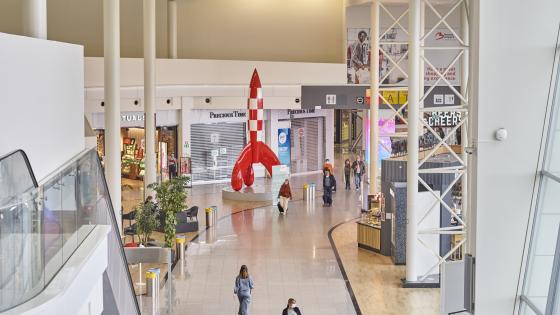
It is hoped that by 2027 less than two-thirds of passengers and staff will travel to the Belgian hub by car
What goes around comes around
Combining rail and air travel is not a new concept. The Silver Arrow, known in French as Flèche d’Argent, once linked Victoria Station in London with Gare du Nord in Paris, via Gatwick and Le Touquet airports. The service ran from the 1950s until the opening of Eurostar in 1994. Where Anglo-French 20th century rail authorities led, airport planners have followed, and work is underway at a number of sites, primarily in Europe, where public transport systems tend to be most advanced. They include Poland’s Centralny Port Komunikacyjny – a planned transfer hub between Warsaw and Łódź, earmarked to open in 2028, which will integrate air, rail and road transport.
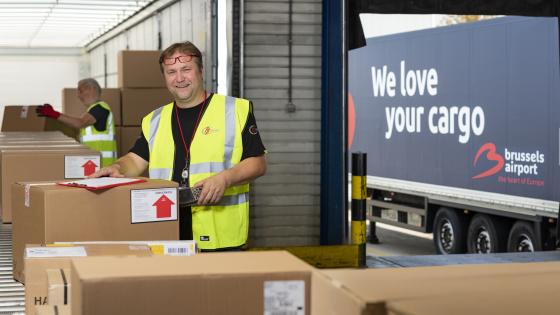
Brussels is keen to position itself as a multimodal airport in both cargo and passenger terms
Incremental expansion
Others are long-established airport hubs that are incrementally expanding their transport connections. London Heathrow, for example, sets out in its strategic brief an ambition to become a “truly multimodal hub” incorporating air, road, rail and water. In January 2022, Heathrow launched its Sustainable Travel Zone (STZ), which aims to deliver multimodal improvements covering rail, tube, bus and coach services as well as active travel. The airport hopes to reduce staff single-occupancy-vehicle trips to, from and around the airport and provide enhanced travel options. These include: late night and early morning public transport catering to 24-hour airport workers; encouraging bus service providers to offer discounted tickets to staff; new cycle and walking routes; secure bike parking; and exploring the integration of local authority cycle hire schemes into the airport through the provision of docking stations.
We are in favour of high-speed rail as a long-term substitute for short-haul flights
Amsterdam’s Schiphol is another airport with an ambition to become a sustainable multimodal hub. One of the busiest airports in Europe, in recent years it has focused on becoming more than just an aviation hub, offering a wide range of transportation options for both passengers and cargo. The current public transport interchange and plaza were built in the 1990s, and since then the number of passengers has increased significantly. The airport has begun construction of a new, larger train station and bus station, dubbed Multimodal Hub Schiphol (MHS), with initial work underway to renovate the station’s lifts and stairs to improve passenger flow and create more space on the platforms and in the plaza above. The end result will be a hub combining various modes of transportation, including buses, trains, aeroplanes, and in the future, the city’s metro.
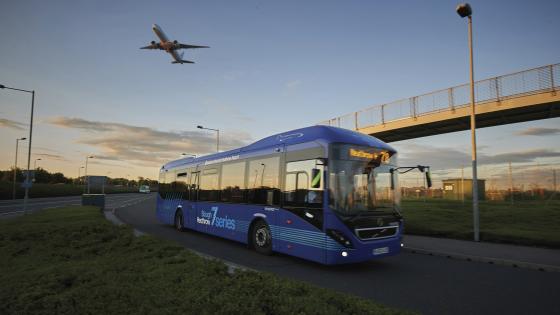
Heathrow bus connection
Early morning public transport is essential for Heathrow’s shift workers
“To achieve our sustainability ambitions and further develop multimodality, Schiphol promotes the increased use of rail and other public transport during journeys to and from our airport,” a Schiphol spokesperson told Airports International. “We are in favour of high-speed rail as a long-term substitute for short-haul flights. To underline this, in 2022 Schiphol facilitated an air-rail pilot by KLM and Thalys, which gave us a unique insight into passenger expectations and experiences. We will further evaluate the pilot and continue to improve the air-rail journey, in line with the air-rail action agenda as presented to the Dutch parliament in 2020.”
Schiphol is due to benefit from the metro extension of the North/South (52) Line to the airport by 2037, adding another low-carbon transport mode alongside train, bus and bicycle. The transformation of Schiphol into a multimodal hub not only benefits passengers and cargo companies (it is well connected by road and close to the major ports of Rotterdam and Amsterdam) but also contributes to sustainable development and economic growth.
Neighbouring Brussels Airport has positioned itself as an intermodal transport hub, too. Supported by the EU’s Green Deal Airport project, it wants to see less than 65% of passengers and staff arriving at the terminal by car by 2027.
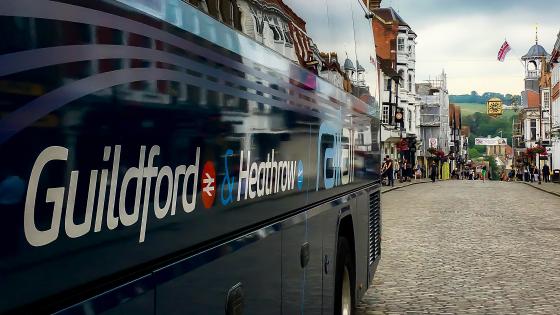
Heathrow encourages bus service providers to offer discounted tickets to staff
Across the pond
On the other side of the Atlantic, Charlotte Douglas International Airport (CLT) in North Carolina has long been a pioneer of multimodal transport hubs – albeit with less of a focus on the active travel options increasingly fostered by European hubs. Its planners worked to connect the airport to local road and rail infrastructure as well as improving access to three major East Coast seaports nearby.
At Orlando International Airport, work begins this year on a $113m pedestrian bridge connecting MCO Terminal C with an existing multimodal facility, to serve up to four forms of passenger rail. A 450ft-long elevated pedestrian walkway is due for completion in 2025, providing easy access to the terminals, train station and a car park.
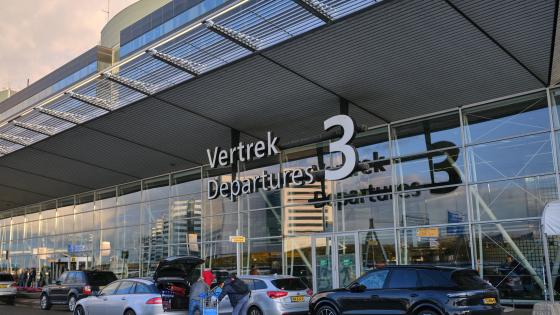
Work is underway at Schiphol to replace the public transport interchange to meet increased passenger demand
Co-operation is key
The utility of multimodal airports, and the impact the integration of multi transport authorities and operators can have on the total environmental impact of a journey, is perfectly demonstrated by the recent announcement of a memorandum of understanding between Lufthansa Group and the Italian state railway company Ferrovie dello Stato Italiane (FS). The deal ensures both parties co-operate with regards to feeder traffic within Italy, to link train and air transport in a better, more customer-friendly way. The aim is to bring passengers with rail connections to and from their flight connections at various Italian airports. The Group operates similar intermodal co-operation programmes with rail operators Deutsche Bahn, ÖBB and SBB. Lufthansa Group airlines currently offer passengers more than 3,000 weekly rail or bus connections from more than 40 cities.
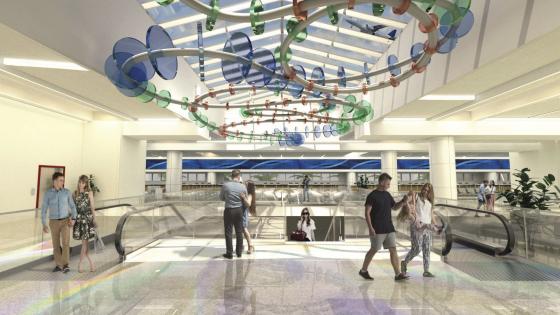
The Weitz Company was chosen to complete the MCO Terminal C Multi-Modal Connector Pedestrian Bridge and Rental Car Lobby
Full integration of different modes of transport is a concept that Conor Hoey, aviation business leader Europe for Arup, agrees with. He argues that decarbonising the door-to-door journey is not as simple as connecting the airport to local metro or bus lines. Rather, the airport, in many cases the largest transport hub in a city, must be an integral part of a wider urban transport network.
“Many of the major European airports have well established multi-modal connectivity systems in place and can exploit these schemes to the advantage of the passenger, thereby improving the passenger experience,” he told Airports International.
An airport must assess the impact a fully integrated multimodal network could have on existing facilities
To achieve this, there are multiple design parameters to consider, including modes of connectivity to be used, levels of connectivity (local, city, national), and anticipated occupancy rates. “Multimodal connected travel feeds into the digital transformation of the transport environment – real-time data sources will influence traffic planning and enhance the passenger experience; full multimodality will enable bag drops in downtown locations, enhancing the passenger journey; connected multimodal tickets will allow an optimum mix of routes and modes,” Hoey said.
This will extend to urban air mobility (UAM) in the future, with electric vertical take-off and landing (eVTOL) aircraft inching closer to lift-off. “The introduction of UAM is likely to see a new mode of travel with airports playing a key role in the likely development of city-wide connected networks.”
But there are cost implications for making this transition. “Not just capital cost but also income considerations," Hoey said. “An airport must assess the impact a fully integrated multimodal network could have on existing facilities. For an existing airport migrating toward this model, the impact of lost parking revenue, for instance, could be significant. Capital costs could be prohibitive and RoI [return on investment] may be challenging if occupancy levels fail to materialise.”
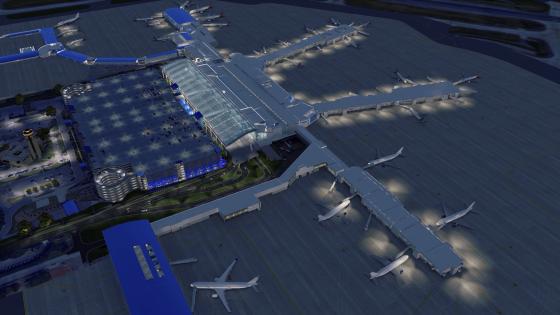
North Carolina’s CLT has been a pioneer of multimodal transport hubs since the early 1990s
Need to know more: The benefits of modelling
Transforming complex airport facilities into multimodal hubs requires innovative technologies. Engineering, architecture, environmental and construction services firm HDR’s industry-first Airport Landside Multimodal Demand Analysis Tool helps airports identify and explore mobility improvements through accurate modelling. The tool “offers a solution that shows the patterns and opportunities hidden in airports’ traffic data”, explained HDR senior traffic engineer Tony Wang, who developed it.
The software has been put to use at New York’s John F Kennedy International Airport, resulting in streamlined data analysis and the standardised development of alternatives. The company said work that previously would have required months was instead completed in weeks. HDR aviation director Bill Peduzzi added: “Modelling the demands of all facilities and transportation modes at an airport in an automated tool is a big benefit for airports. With this process, we can quickly and accurately assess existing conditions. We can then determine the best future balance of roadways, dedicated lanes, parking and more, both during construction and in normal operations.” Software developer InControl was also part of that process, having been requested by Amsterdam’s Schiphol Airport to act as a passenger flow specialist, with a team of engineers simulating the infrastructure of the new Multimodal Hub Schiphol.
